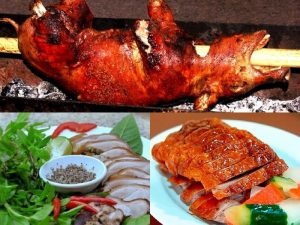
A journey to Northwest Vietnam isn’t complete without riding along its winding mountain roads — challenging yet breathtakingly poetic. And when you finally arrive, your trip won’t truly be complete until you’ve tasted the region’s famous specialties: smoked buffalo meat and the irresistible aroma of grilled dishes seasoned with wild mắc khén pepper and dổi seeds.
Today, let’s explore one of the most beloved mountain dishes: Northwest-style Grilled Ethnic Pork — known locally as thịt heo tộc nướng Tây Bắc.
This type of pork comes from free-range mountain pigs raised by local ethnic families in the highlands. They roam freely through forest gardens, feeding naturally on roots and wild plants, which gives the meat a firm texture, rich flavor, and natural sweetness — a true product of the mountains.
Traditionally, this dish is best enjoyed by the streamside, grilled slowly over charcoal fire, while the smoke mingles with the fresh scent of forest herbs. Sitting beside the fire, listening to the murmur of the stream, watching the green canopy sway, breathing in the earthy fragrance of mắc khén and dổi seeds, and tasting the warm, tingling spice of the meat — it’s a moment when you feel completely one with the mountains.
Ingredients
- 400g local mountain pork (free-range ethnic pork)
- 5 wild dổi seeds
- 2 teaspoons mắc khén pepper (a unique mountain spice similar to Sichuan pepper)
- A few lá mắc mật (local aromatic leaves) and coriander
- 1 lemongrass stalk, 3 shallots, 2 wild chili peppers (ớt sim)
- 1 teaspoon honey
- 1 teaspoon seasoning powder
- 1 clay or terracotta tile (for grilling)
How to Prepare
- Clean and drain the pork, then cut it into bite-sized pieces (or leave as whole chunks if preferred).
- Lightly roast the wild dổi seeds and mắc khén pepper until fragrant, then pound finely. Set aside one-fifth of this mixture to make chẳm chéo, the traditional dipping sauce.
- Finely chop lemongrass, shallots, coriander, and chili.
- Combine the pork with the remaining spice mix, add chopped herbs, seasoning powder, and honey. Marinate for about 40 minutes.
- Heat a terracotta tile (previously soaked in water to prevent cracking) over medium heat. Brush with a little oil, then place the pork pieces in the center. Arrange fresh herbs and dipping sauce around for serving.
As the pork begins to sizzle, a wave of fragrance fills the air — smoky, nutty, and earthy all at once. Each piece, once golden brown, carries the unmistakable flavor of the Northwest: wild, spicy, and deeply aromatic. Dip it into the chẳm chéo sauce, chew slowly, and let the taste of the mountains unfold in every bite.
Now raise your glass — let’s toast to the highlands, where every meal feels like a celebration of nature itself.
🟤 “Ethnic Pork” (or “Local Mountain Pork”) refers to the free-range native pigs raised organically by ethnic families across the Northwest — including Sapa. Their naturally flavorful meat has become a proud symbol of the region’s rustic cuisine.
